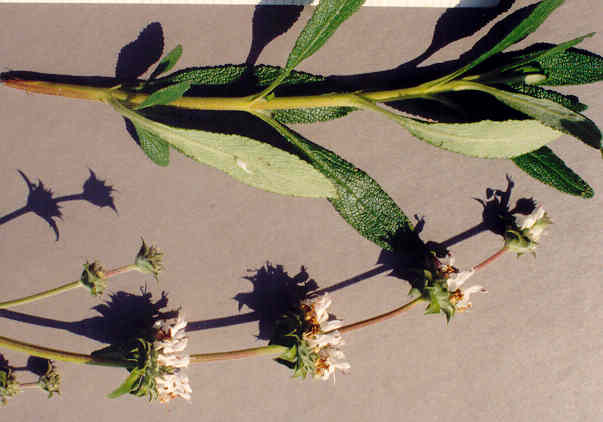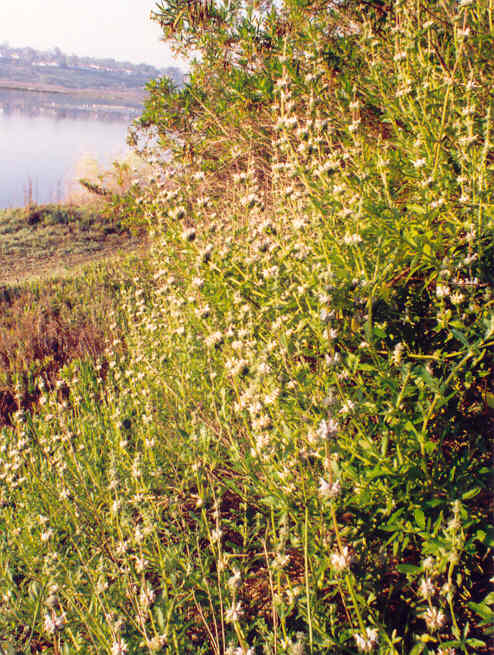
Salvia mellifera E. Greene
 |
Salvia mellifera E. Greene
Lamiaceae (Mint Family)NativeBlack Sage |
May Photo
Plant Characteristics:
Openly branched aromatic shrub 1-2 m. tall, with herbaceous leafy strigulose
twigs, +/- glandular; lvs. opposite, lf. blades oblong-elliptical, 2-6 cm. long,
obtuse, green and somewhat rugulose above, cinereous-tomentulose beneath,
crenulate, subsessile or on petioles to 12 mm. long; fls. many in compact
glomerules, 2-4 cm. in diam. with ovate greenish cuspidate bracts 5-10 mm. long,
intervals between glomerules mostly 2-6 cm. long; calyx 6-8 cm. long, villous,
+/- glandular, the lower teeth free, 1.5-2 mm. long, the upper connate; corolla
strongly 2-lipped, pale blue or whitish, sometimes lavender, ca. 12 mm. long,
the lower lip almost equal to tube, with notched middle lobe; stamens inserted
in throat, the upper pair sterile or rudimentary, the lower pair fertile with
anther-cells widely separate on a long filament-like connective which exceeds
the filament itself and is jointed to it, exserted; nutlets smooth, ca. 2 mm.
long.
Habitat:
Common on dry slopes and benches, below 2000 ft.; Coastal Sage Scrub, Chaparral;
n. L. Calif. to cent. Calif. April-July.
Name:
Latin, salveo, the verb to
save, because of medicinal use. (Munz,
Flora So. Calif. 535).
Latin, mel, honey and Latin fero,
to bear. (Jaeger 102, 152).
Mellifera, honey bearing,
pertaining to the nectar in the flowers. (my
comment).
General:
Rare in the study area, found only once and this in the lower Santa Ana
Heights area, approx. 1/8 mile from Jamboree road.
In 2005, a single plant was found growing in the sand at
the northerly end of Shellmaker Island. In 1996 a plot of native flowering
plants was seeded on the bank southerly of a line extending Mesa Drive to the
bay. There are several S. mellifera in this area. See S.
apiana for additional information on the planting of the area. (my comments).
S. mellifera is used as tea and
the early settlers used it to season sausage, poultry and meat stuffings.
(Clarke 111). Indians gathered the tiny seeds,
parched them and made them into meal. Black
Sage became a common name because the whorls of blooms remain after they set
seed forming dark spheres along the dry stalks.
(Dale 132).
The black sage provided the Cahuilla, Indians of the Colorado Desert, the
San Bernardino and San Jacinto mountains, with both food and condiment.
The plant blooms later than chia, (Salvia
columbariae), extending the
gathering period for this species. The
seeds were gathered, parched and ground into a meal. The seeds are highly nutritious and have a rich nutty
flavor. Leaves and stalks
were gathered in the spring from April through May and used as a food
flavoring. (Bean &
Saubel 138).
Black Sage has long been considered by bee keepers to be one of the best
sources of honey in southern California. (Belzer
100). A tea made from Salvia
species, will decrease secretions, from sweating, salivation, and milk
secretions to mucous secretions of the sinuses, throat, and lungs.
It is the best herbal treatment for decreasing lactation during weaning
in either animals or humans, a cup before each meal as long as needed.
A cold cup of the tea is a good stomach tonic, particularly for ulcers
and stomach inflammations. It has a
substantial effect on diarrhea that is small intestinal in origin.
The lukewarm tea sufficiently bacteriostatic and astringent to make it
useful for treating nearly all sore throats, both gargled and then drunk. Because it decreases
sweating it is most useful along rather than combined with such sweat stimulants
and peppermint, Elder, or Yarrow. A
rounded teaspoon of the crushed leaves is a reliable uterine hemostatic tea,
good for heavy menstruation but inadvisable for the new mother who plans to
nurse. (Moore, Medicinal
Plants of the Mountain West
142). Delfina
Cuero, a Kumeyaay or Southern Diegueno Indian, made the following comments about
S. mellifera in her autobiography.
"We used it for medicine. The
leaves and stems could be used fresh or dried.
They were boiled and the water used for bathing when a person ached due
to flu, rheumatism and arthritis." (Shipek 96).
Salvia flowers present their pollen-laden anthers to the thorax of a
visiting honey bee. After the
anthers have released all pollen, the "aloof" stigma bends down, ready
to receive pollen from another flower. In
this manner self-pollination is avoided. (Ross,
Edward S. "Insect/Plant
Relationships: A Photographic Essay" FREMONTIA, A Journal of the
California Native Plant Society. April
1996 pp. 3-22.)
Flowers that are rich in nectar such as Salvia
ensure pollination by depositing their pollen on the foraging bee’s back.
Pollen deposited in this manner (a process called nototriby) cannot be
packed into loads destined as brood food back in the nest.
The pollen is eventually deposited to the stigma of another flower as the
bee continues to feed. (Thorp, Robbin W., Schroeder, Peter C., and Ferguson,
Carol S. “Bumble Bees: Boisterous
Pollinators of Native California Flowers”
FREMONTIA, A Journal of the California Native Plant Society.
Vol. 30 Nos 3-4 July-Oct. 2002 pp. 26-31).
A genus of over 500 spp., widely distributed in temp. and warmer regions;
some cultivated as ornamentals or for flavoring.
(Munz, Flora So. Calif. 535).
Hybridizes freely with S.
columbariae, S. x bernardina, and S. leucophylla, sometimes with S.
carduacea and S. clevelandii. (Munz, Flora So. Calif.
538).
Text Ref:
Hickman, Ed. 728; Munz, Flora So.
Calif. 538.
Photo Ref:
May 96 #8, 10; Jan-Mar 97 # 22A,23A.
Identity: by R. De Ruff,
confirmed by John Johnson.
First Found: May 1996.
Computer Ref: Plant Data 494
Have plant specimen.
Last edit 2/16/05..
 |
May Photo